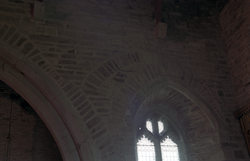
The Corpus of ROMANESQUE SCULPTURE in Britain & Ireland

St Stephen (medieval)
Parish church
Lympne is a village situated about 0.5 mile N of West Hythe, less than 2 miles distant from the Channel coast. The church of St Stephen is a substantial building perched at the edge of a long downwards escarpment looking towards the coast. It comprises a nave, a central tower, a N aisle and a porch. There are two known 19thc restorations. Romanesque work includes the tower arches, tower windows, and font, together with some reset chip carving in the early Gothic N aisle window.
Parish church
The present church is a complete construction of 1835 by John Barry. The single Romanesque feature is a reset arch incorporated into a lychgate.
The chapel destroyed in 1835 to facilitate the new building was a small 12thc building with an aisleless nave and chancel. The richly sculpted arch of the south door was re-erected in the churchyard wall to form the main entrance where it has weathered (VCH. Vol 2, 424).
Parish church
The body of the church is Perpendicular, although clearly not all of one build. The only feature earlier than the 15thc is the Romanesque font.
Parish church
Rossington is a village about five miles SE of Doncaster. The church lies in a wooded churchyard just off Sheep Bridge Lane between Rossington to the E and New Rossington to the W; it is a Magnesian limestone and sandstone ashlar building comprising a chancel, a modern transepts, a long nave with a S porch, and a W tower. Between 1840 and 1844 the purchaser of the Rossington estate, James Brown, rebuilt the church except for the Perpendicular W tower, the Romanesque chancel arch and the S doorway; he added transepts and a vestry. 20thc renovations added rooms to the upper levels of the N transept. The unusual length of the aisleless nave, approximately 18m between the tower and the chancel arch, is original. Romanesque sculpture survives in the chancel arch, in the S doorway and on the font.
Parish church
According to Sedding, the lower part of the nave N wall, the N and S walls of the chancel, the walls of both transepts, the inner arches of the original round-headed windows and much of a semicircular arch of the chancel remain from the Norman church. Pevsner also noticed traces of round-headed arches in the transepts. The only remains of Romanesque sculpture are the font and the two panels in the outside wall of the chancel. The figure panels date from the third quarter of the 11thc, the early Norman or Saxo-Norman overlap period. The font is of the first half of the 12thc.




